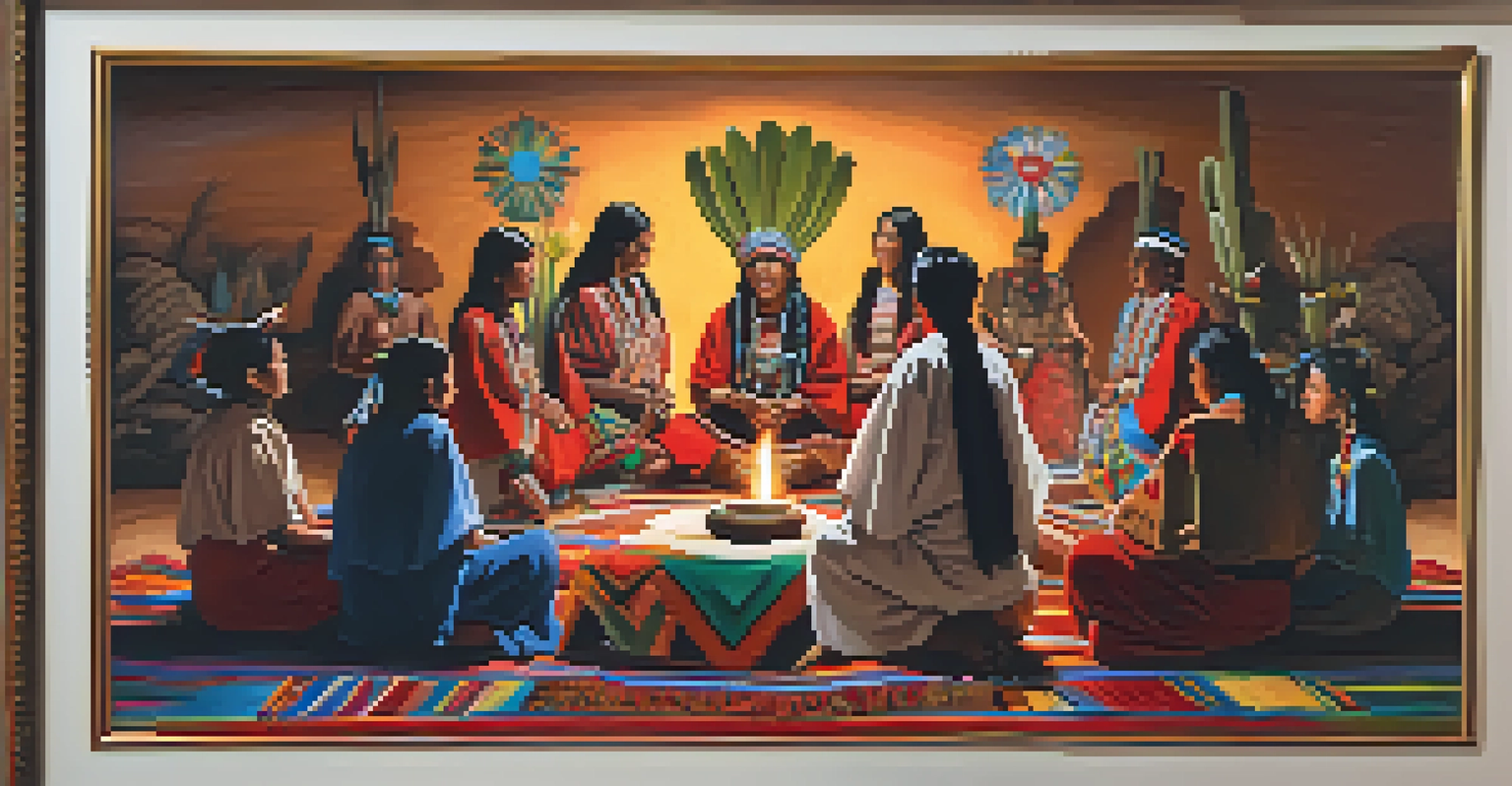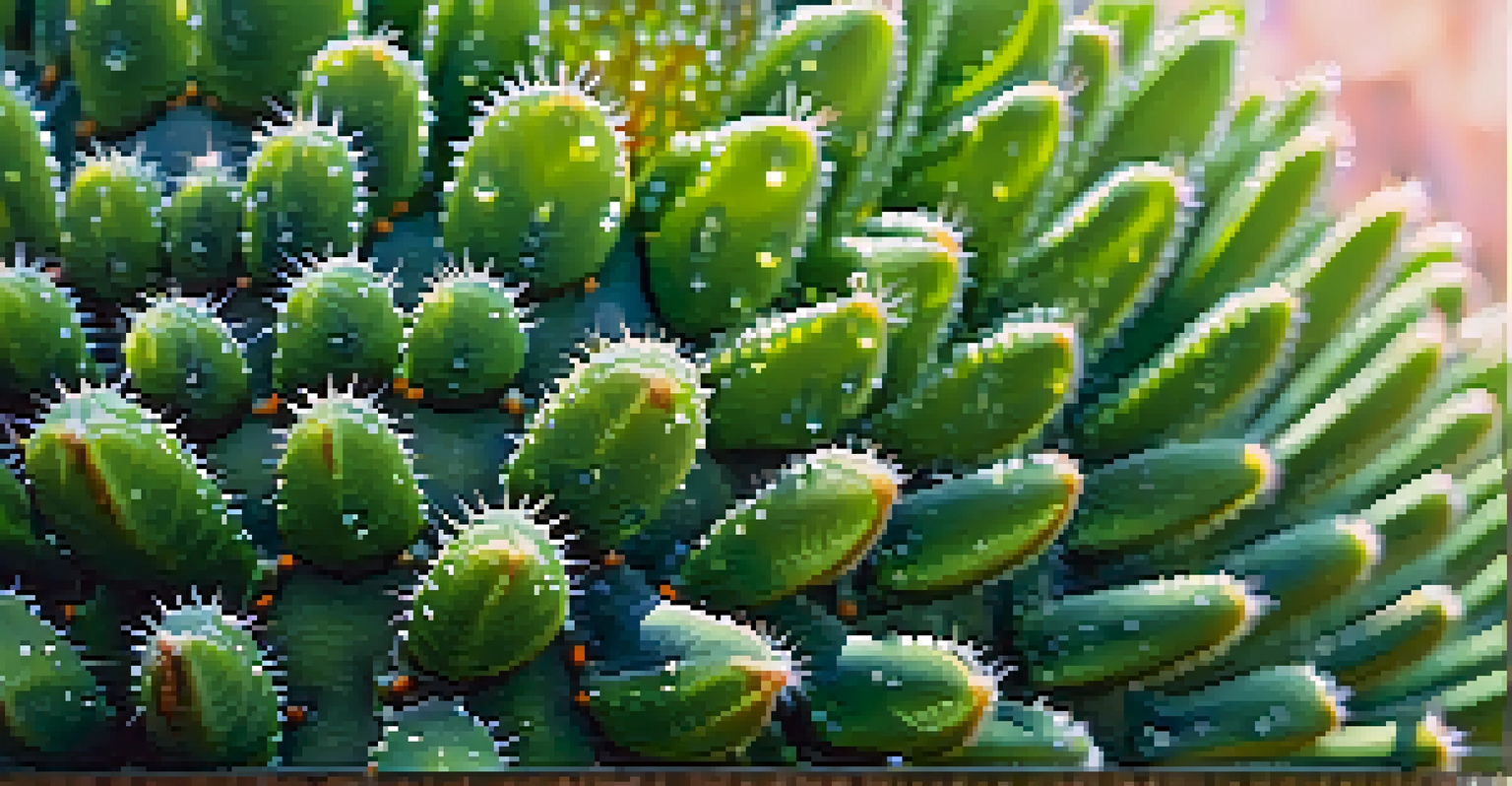Cultural Significance: Peyote vs. Other Psychedelic Substances

Understanding Peyote's Historical and Cultural Context
Peyote, a small cactus native to Mexico and the southwestern United States, has been used for thousands of years in indigenous spiritual practices. Notably, the Native American Church incorporates peyote into its ceremonies, viewing it as a sacrament that facilitates communion with the divine. This rich history sets peyote apart from many other psychedelics, which often lack such deep-rooted cultural ties.
Psychedelics can serve as a tool for personal transformation and communal healing, but they must be approached with respect for their cultural origins.
In contrast, substances like LSD and psilocybin mushrooms emerged in the 20th century and were primarily popularized in Western counterculture. While they have been embraced for their mind-expanding properties, their cultural significance pales in comparison to that of peyote. This difference highlights how the context of use can shape the meaning and value of a psychedelic substance.
Related Resource
Moreover, peyote's use is often intertwined with community rituals and healing practices, emphasizing a collective experience rather than individual exploration. This communal aspect fosters a sense of belonging among users, reinforcing the cultural importance of peyote within Native American traditions.
Peyote's Role in Spiritual Practices
For many indigenous peoples, peyote serves as a bridge to the spiritual realm, offering insights and guidance during ceremonial use. The experience is often described as transformative, leading to personal revelations and a deeper understanding of oneself and the universe. This spiritual dimension is a core aspect of peyote's cultural significance, making it distinct from other psychedelics that may not carry the same sacred weight.

In ceremonies, participants often engage in singing, drumming, and storytelling, creating a rich tapestry of cultural expression. These activities enhance the peyote experience, reinforcing its importance in spiritual and communal life. On the other hand, psychedelics like ayahuasca, while also used in ritual contexts, come from different cultural backgrounds and serve varying purposes.
Peyote's Deep Cultural Roots
Peyote is embedded in indigenous spiritual practices, distinguishing it from other psychedelics that lack such cultural significance.
The sacredness of peyote is recognized legally in the United States, where its use is protected for members of the Native American Church. This legal recognition not only affirms its cultural importance but also underscores the need to respect and preserve indigenous traditions surrounding peyote use.
Comparing Peyote with Western Psychedelics
When comparing peyote with popular Western psychedelics, such as LSD or MDMA, the differences in cultural significance become even more pronounced. While LSD is often associated with personal exploration and psychological therapy, peyote is deeply rooted in tradition and spirituality. This contrast highlights how cultural context can shape the perception and application of these substances.
Understanding the cultural significance of substances like peyote is essential to preserving their integrity and the traditions that surround them.
Psychedelics like psilocybin are increasingly studied for their therapeutic effects, but their use is often approached from a clinical perspective. In contrast, peyote is primarily used within a framework of cultural rituals that emphasize healing on a spiritual level. This distinction speaks to the broader implications of how societies interpret and integrate these substances into their practices.
Related Resource
Furthermore, as interest in psychedelics grows, it's essential to acknowledge and respect the cultural origins of substances like peyote. Appropriating these practices without understanding their significance can lead to a disconnect from their intended purpose and meaning.
Social and Legal Implications of Peyote Use
The legal status of peyote in the United States allows for its use in religious contexts, providing a framework for its preservation within Native American cultures. However, outside of these circles, the use of peyote is often stigmatized or misunderstood. This creates a divide between those who honor its traditional use and those who view it purely as a recreational substance.
In contrast, substances like MDMA and psilocybin have gained popularity in both therapeutic and recreational settings, leading to ongoing discussions about their legalization. This shift highlights the differing societal perceptions of peyote compared to other psychedelics, which often lack the same cultural narrative that supports their use.
Spiritual vs. Therapeutic Use
While peyote emphasizes communal and spiritual growth, modern psychedelics often focus on individual therapeutic benefits.
As discussions around drug policy evolve, recognizing the unique cultural significance of peyote is crucial for fostering respect and understanding. Advocating for the preservation of traditional practices surrounding peyote can help bridge gaps between indigenous communities and broader society.
Psychedelics in Modern Therapy vs. Peyote's Traditional Use
In recent years, psychedelics have made a resurgence in therapeutic contexts, with studies showing promising results for mental health treatments. Substances like psilocybin and ketamine have garnered attention for their potential to assist in healing trauma and depression. However, this modern approach often contrasts sharply with the traditional use of peyote, which emphasizes spiritual growth rather than psychological healing.
While both contexts value the transformative potential of psychedelics, the underlying motivations differ significantly. Psychedelic therapy focuses on individual healing and symptom relief, whereas peyote ceremonies prioritize communal experience and connection to spirituality. This distinction is essential in understanding how each substance serves its respective communities.
Related Resource
Moreover, the therapeutic framework can sometimes unintentionally commodify psychedelics, stripping them of their cultural significance. In contrast, peyote's use remains deeply embedded in indigenous traditions, illustrating the importance of maintaining cultural integrity in discussions about psychedelics.
Peyote's Environmental and Ethical Considerations
As interest in peyote grows outside of indigenous communities, concerns about sustainability and ethical sourcing have emerged. Overharvesting of peyote can pose a threat to its natural populations, leading to potential ecological imbalance. This situation raises critical questions about the responsibility of individuals who seek to use peyote for personal or recreational purposes.
In comparison, other psychedelics, such as synthetic substances, present different environmental impacts. While they may not face the same overharvesting issues, the production of these substances can have significant ecological footprints. This underscores the need for a broader understanding of environmental ethics in relation to all psychedelic substances.
Sustainability and Ethical Concerns
As interest in peyote grows, addressing environmental sustainability and ethical sourcing becomes crucial to preserve its cultural and ecological integrity.
Ultimately, the conversation around peyote should include discussions about sustainability and ethical practices. Respecting the traditional knowledge and practices of indigenous peoples is vital in ensuring that peyote continues to thrive both culturally and ecologically.
Conclusion: The Importance of Cultural Respect
In conclusion, the cultural significance of peyote stands in stark contrast to the narratives surrounding many modern psychedelics. Its deep-rooted history within indigenous practices highlights the need for respect and understanding when discussing its use. As society continues to explore the potential benefits of psychedelics, it’s crucial to recognize and honor the traditions that have preserved these substances for centuries.
By fostering respect for peyote and its cultural context, we can better appreciate the diverse ways in which psychedelics can be understood and integrated into our lives. This approach not only enriches our perspective but also ensures that the voices of indigenous communities are heard and valued.

As we navigate the evolving landscape of psychedelics, let us remember the importance of cultural heritage and the role it plays in shaping our understanding of these powerful substances.